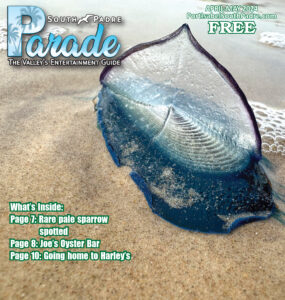By Steve Hathcock
Special to the Parade
I remember reading an article one time, where the author wrote; “There is a sunken ship for every mile of shoreline along the Texas Coast.”
Early Spanish records are full of shipwreck accounts. For instance; in November 1527, an unexpected, late season storm struck Galveston Island. A merchant fleet, seeking harbor in Matagorda Bay was sunk taking 200 lives and millions of dollars worth of treasure to the bottom.
This is the first recorded hurricane along the Texas Coastline and is one of the most unusual because only one other hurricane has ever struck this coastline during the month of November (1839).
On September 4, 1766, a major hurricane struck Galveston. A richly-laden treasure fleet of five galleons en route from Vera Cruz to Havana was driven ashore and had to wait many weeks for assistance to come. Fortunately, most of the treasure and people aboard were saved.
The list goes on and on. How many wrecks remain to be found is anybody’s guess. But the most famous of the Texas shipwrecks occurred over 470 years ago.
Four treasure galleons, loaded with the stolen wealth of the Aztec Nation, sailed from Vera Cruz Harbor in the predawn morning of April 29, 1554. The fleet set a course north along the coast until they reached a point near modern day Kingsville Texas. Here the ships caught an easterly current that would carry them across the Gulf of Mexico to the harbor at Havana Cuba. From there, the treasure ships would continue east, past the Bahamas and into the Atlantic. All went well until they were only a day or so off the coast of Cuba. Suddenly and with little warning, a great storm sprang up.
One ship, the San Andreas became separated from the fleet shortly after the storm struck. The captains of the other three galleons the Espiritu Santo, the Santa Maria de Yicar and the San Estabon, managed to keep the fleet together as they turned west, back into the Gulf of Mexico in an attempt to outrun the storm. After three days they ran out of sailing room, running hard aground on a sand bar just offshore and about midway up Padre Island. Approximately, 300 sailors and passengers survived the initial shipwrecks. A crude barge was constructed of wood and sails salvaged from the wrecks, which were easily accessible during low tide. About thirty people boarded the rickety raft and sailed south in search of help. The other survivors remained with the ships. There was plenty of edible food and water aboard the wrecks so they had no reason to be concerned about their safety while they waited.
The days went by slowly. There was not any shade for the stranded Europeans and it was very hot. Clouds of biting bugs hovered day and night and everyone’s eyes were swollen from multiple insect bites, heat exhaustion and sunburn. By the sixth day they could no longer wait for help. The Spaniards thought they were within walking distance of a military outpost located near the mouth of the Panuco River in Mexico. Somewhere along the beach, they expected to meet their rescuers, or so they hoped.
Along the way, local Indians attacked them. All were killed except one, a priest whose account was recorded 40 years later. (See Behind the Third Dune by Steve Hathcock).
Miraculously, the thirty survivors who had built the raft and sailed south shortly after the shipwreck, made it to safety.
The officials in Mexico City promptly organized a salvage expedition. Arriving at the wreck sites, the salvage crew found one of the three ships still visible above the waves. Free-diving workers began recovery operations and the other two wrecks were quickly located. The salvage expedition recovered nearly half of the treasure but the greater part of it escaped detection and was left behind on the shores of Padre Island, where it still lies today.
Francisco Vasquez was still waiting at the site for rescue when the salvers arrived. He told his rescuers how he had hidden aboard the wrecks, coming out only at night, so the savage Indians who hunted down and killed his companions would not capture and kill him, too. After returning to Spain, he was awarded a royal pension for his efforts and retired to Spain.
What happened to the San Andreas?
Badly battered, it managed to make port at Havana Harbor but was to damaged to continue the voyage. It’s cargo of mostly gold and silver, was divided between two other outbound ships, the Nuestra Senora del Rosario and the San Miguel. Both ships arrived in Spain in the early part of January, 1555.



Comments